Annunciation of the Blessed Virgin Mary
இயேசு பிறப்பின் முன்னறிவிப்பு
(Annunciation of the Lord)
திருவிழா நாள்: மார்ச் 25
இயேசு பிறப்பின் முன்னறிவிப்பு அல்லது மங்கள வார்த்தை அறிவிப்பு என்பது லூக்கா நற்செய்தி 1:26-38ல் உள்ளபடி கபிரியேல் தேவதூதர், கன்னி மரியாளுக்கு தோன்றி, அவர் தூய ஆவியினால் கருவுற்று ஒரு மகனைப் பெற்று இயேசுவின் தாயாவார் என்பதனை அறிவித்த நிகழ்வாகும். இந்த நிகழ்வின்போதே மரியாளிடம் கபிரியேல் தூதர் பிறக்கவிருக்கும் குழந்தைக்கு, இயேசு என பெயரிடச்சொன்னார். மேலும், திருமுழுக்கு யோவானின் பிறப்பையும் மரியாளிடம் எடுத்தியம்பினார். மரியாளின் உறவினராகிய எலிசபெத்தும் தமது முதிர்ந்த வயதில் ஒரு மகனைக் கருத்தரித்திருக்கிறார் எனவும் கருவுற இயலாதவர் என்று சொல்லப்பட்ட அவருக்கு இது ஆறாம் மாதம் எனவும் கபிரியேல் மரியாளுக்கு அறிவித்தார்.
பல கிறிஸ்தவ பிரிவுகள் இந்நிகழ்வை மார்ச் 25ம் நாளன்று கொண்டாடுகின்றனர். இது இயேசு பிறப்புக்கு ஒன்பது மாதங்களுக்கு முன் என்பதுவும் இது இயேசுவின் பாடுகளின் காலத்தில் நிகழ்கின்றது என்பதும் குறிக்கத்தக்கது. இத்தேதியினை முதன் முதலில் இவ்விழாவுக்கென கொண்டவர் இரனேயு (காலம்.130-202) ஆவார்.
முக்காலத்தில் சம இரவு-பகல் நாளினை ஒட்டி இவ்விழா நிகழ்ந்ததால், இது புத்தாண்டாக பல நாடுகளில் கொண்டாடப்பட்டது. கத்தோலிக்க திருச்சபையினரால் இந்நிகழ்வு முன்னறிவிப்பு பேராலயத்தில் நடந்ததாக நம்பப்படுகின்றது. ஆயினும் பிற கிறிஸ்தவ சபைகளிடையே இது குறித்த ஒத்த கருத்தில்லை.
கத்தோலிக்க திருச்சபையில், இயேசு பிறப்பின் முன்னறிவிப்பு நிகழ்வு, செபமாலையின் மகிழ்ச்சி மறைபொருள்களின் முதல் மறைபொருள் ஆகும்.
Also known as
• Annunciation of the Lord
• Annuntiatio Christi
• Annuntiatio Dominica
• Annuntiatio Mariae
• Annuntio Domini
• Christ's conception
• Christ's incarnation
• Conceptio Christi
• Feast of the Incarnation
• Festum Incarnationis
• Incarnation Christi
• Initium Redemptionis Conceptio Christi
• Mary's Annunciation
Profile
The annunciation to the Blessed Virgin Mary by Gabriel the Archangel that she was to be the Mother of God (Luke 1), the Word being made flesh through the power of the Holy Spirit. The feast probably originated about the time of the Council of Ephesus, c.431, and is first mentioned in the Sacramentary of Pope Gelasius (died 496). The Annunciation is represented in art by many masters, among them Fra Angelico, Hubert Van Eyck, Jan Van Eyck, Ghirlandajo, Holbein the Elder, Lippi, Pinturicchio, and Del Sarto.
St. Harold
Feastday: March 25
Death: 1168
Martyred child of Gloucester, England. He was reported to have been slain by Jews in the area, and was venerated as a martyr. The veneration of the child martyrs is often considered as an example of the pervasive anti-Semitism of the period
St. Robert of Bury
Feastday: March 25
Death: 1181
Traditionally, a boy martyr of the Middle Ages whose death was blamed upon local Jews. He was supposedly kidnapped and murdered by Jews on Good Friday at Bury St. Edmunds, England. As was the case with other reputed victims of Jewish sacrificial rites, the story of Richard is entirely fictitious and owes its propagation to the rampant anti-Semitism of the period.
Saint Robert of Bury (died 1181) was an English boy, allegedly murdered and found in the town of Bury St Edmunds, Suffolk in 1181. His death, which occurred at a time of rising antisemitism, was blamed on local Jews.[1] Though a hagiography of Robert was written, no copies are known, so the story of his life is now unknown beyond the few fragmentary references to it that survive. His cult continued until the English Reformation.
Robert of Bury joined a small group of 12th-century English unofficial saints of strikingly similar characteristics: all young boys, all mysteriously found dead and all hailed as martyrs to alleged anti-Christian practices among Jews. Contemporary assumptions made about the circumstances of their deaths are typical of blood libel. The first of these was William of Norwich (d.1144), whose death and cult were probably an influence on the story that grew up around the death of Robert.
Saint Nicodemus of Mammola
Also known as
• Nicodemus of Cirò
• Nicodemus of Cellerano
• Nicodemus of Kellerano
• Nicodemo of...
Additional Memorials
• 12 March (Mammola, Italy and surrounding area)
• Sunday after 12 May (founding of the Monte Cellerano monastic community)
• 1st Sunday in September (translation of relics in 1501)
Profile
Son of Theophanes and Pandia. Educated by a local priest, Father Galatone, known for his learning and piety. Even as a young man, Nicodemus was disgusted by the mis-spent lives of his contemporaries, and was drawn to the monastic life. He tried to join the monks in the San Mercurius abbey on Mount Pollino in the Calabria region of Italy; it was a hard, ascetic life for these monks, dressed in goat skins, going bare-foot in all seasons, surviving on chestnuts and lupins with a cave for shelter and some straw for a bed, and Nicodemus was initially turned away by the abbot, Saint Fantinus, who thought the young man’s health too frail for a monk‘s life. But Nicodemus persevered, and Fantinus eventually relented and welcomed him to the community. Brother monk with Saint Nilus of Rossano.
Feeling the need for greater solitude, Nicodemus withdrew to live as a hermit on Monte Cellerano in Locri, Italy. His reputation for wisdom and piety followed him, though, and he soon attracted several spiritual students, and organized them in to a colony that lived separately but met once a week. However, his community became too well known; there were too many would be students, too many lay visitors, and too many incursions by Saracen invaders. The monks dispersed to various monasteries. Nicodemus moved first to a house in Gerace, Italy, and then to a monastery near Mammola, Italy where he spent the rest of his life. His reputation for holiness was such that, upon his death, the monastery was renamed San Nicodemo in his honour.
Born
early-10th century in Cirò, Catanzaro, Italy
Died
• 25 March 990 in the monastery at Mammola, Calabria, Italy (a house then renamed San Nicodemo) of natural causes
• interred in a tomb in a small oratory at the monastery
• oratory re-built into a large church by Normans in 1080
• relics transferred to the church of Mammola in 1580
• his chapel was re-built and decorated in the city of Mammola in 1884
• relics surveyed and re-enshrined on 12 May 1922
Saint Dismas
புனிதர் தீஸ்மாஸ்
(St. Dismas)
நல்ல கள்வன்:
(Penitent thief)
இறப்பு: சுமார் 30-33 கி.பி
கொல்கொதா மலை, யெரூசலமுக்கு வெளியே
(Golgotha Hill, outside Jerusalem)
ஏற்கும் சபை/ சமயம்:
கத்தோலிக்க திருச்சபை
(Catholic Church)
கிழக்கு மரபுவழி திருச்சபை
(Eastern Orthodox Church)
சித்தரிக்கப்படும் வகை:
சிலுவையில் இயேசு கிறிஸ்துவின் அருகில் அறையப்பட்டிருப்பது போல.
நினைவுத் திருவிழா: மார்ச் 25
காவல்:
மரணதண்டனை விதிக்கப்பட்டுள்ள கைதிகள், சவப்பெட்டி செய்வோர்; மனம்மாறிய கள்வர்கள்;
நல்ல கள்வன் அல்லது மனம்மாறிய கள்வன் என்பவர் லூக்கா நற்செய்தியில் பெயர் குறிப்பிடப்படாமல், சிலுவையில் இயேசு கிறிஸ்துவின் இரு பக்கத்திலும் அறையப்பட்ட கள்வர்களுள் ஒருவராவார்.
பாரம்பரியப்படி இவரின் பெயர் புனிதர் தீஸ்மாஸ் ஆகும். இவர் சிலுவையில் தன் பாவங்களுக்காய் மனம் வருந்தி இயேசுவிடம் மன்னிப்பு பெற்று விண்ணகம் சென்றார் என்பது விவிலிய அடிப்படையில் கிறிஸ்தவ நம்பிக்கை ஆகும்.
விவிலியத்தில்:
இயேசுவோடு அவரின் வலப்புறம் ஒருவனும் இடப்புறம் ஒருவனுமாக இரு கள்வர்களை சிலுவைகளில் அறைந்தார்கள் என விவிலியம் கூறிகின்றது.
(மத்தேயு 27:38, மார்க் 15:27-28, லூக்கா 23:33, யோவான் 19:18).
இந்நிகழ்வை மாற்கு, ஏசாயா 53:12ல் உள்ள மறைநூல் வாக்கு நிறைவேறியதாக கூறுகின்றார்.
மத்தேயு, இரண்டு கள்வர்களுமே இயேசுவை பழித்துரைத்ததாக கூறுகின்றார் (மத்தேயு 27:44).
ஆயினும் லூக்கா பின்வருமாறு இந்நிகழ்வை விவரிக்கின்றார் : ( 23 : 39 - 43 )
39 சிலுவையில் தொங்கிக்கொண்டிருந்த குற்றவாளிகளுள் ஒருவன், "நீ மெசியாதானே! உன்னையும் எங்களையும் காப்பாற்று" என்று அவரைப் பழித்துரைத்தான். 40 ஆனால் மற்றவன் அவனைக் கடிந்து கொண்டு, "கடவுளுக்கு நீ அஞ்சுவதில்லையா? நீயும் அதே தீர்ப்புக்குத்தானே உள்ளாகி இருக்கிறாய். 41 நாம் தண்டிக்கப்படுவது முறையே. நம் செயல்களுக்கேற்ற தண்டனையை நாம் பெறுகிறோம். இவர் ஒரு குற்றமும் செய்யவில்லையே!" என்று பதிலுரைத்தான். 42 பின்பு அவன், "இயேசுவே, நீர் ஆட்சியுரிமை பெற்று வரும்போது என்னை நினைவிற்கொள்ளும்" என்றான். 43 அதற்கு இயேசு அவனிடம், "நீர் இன்று என்னோடு பேரின்ப வீட்டில் இருப்பீர் என உறுதியாக உமக்குச் சொல்கிறேன்"
Also known as
• The Good Rogue
• The Good Thief
• The Penitent Thief
• Demas, Desmas, Dimas, Dysmas, Rach, Titus, Zoatham
Memorial
25 March; date derived from a tradition that this was the calendar date of the Crucifixion, though the Passover and Easter celebrations move from year to year
Profile
One of the thieves crucified with Jesus, the other being traditionally known as Gestas; Dismas is the Good Thief, the one who rebuked the other, and asked for Christ's blessing.
An old legend from an Arabic infancy gospel says that when the Holy Family were running to Egypt, they were set upon by a band of thieves, including Dismas and Gestas. One of the highwaymen realized there was something different, something special about them, and ordered his fellow bandits to leave them alone; this thief was the young Dismas.
Died
crucified c.30 at Jerusalem
Patronage
• condemned prisoners
• death row prisoners
• dying people
• funeral directors
• penitent criminals
• prison chaplains
• prisoners
• prisoners on death row
• prisons
• reformed thieves
• undertakers
• Przemysl, Poland, archdiocese of
• Merizo, Guam
Blessed Josaphata Mykhailyna Hordashevska
Also known as
• Giosafata Hordasevska
• Michalina Jozafata Hordaszewska
• Mykhailyna Hordashevska
• Yosafata Hordashevska
Profile
Greek Catholic. Entered the contemplative Basilian Sisters at age 18. When the Basilians decided to establish a woman's congregation that focused on the active life, sister Mykhailyna was chosed to lead it. First member of the Sisters Servant of Mary Immaculate, taking the name Josaphata, from Saint Josaphat.
The Sister Servants "serve Your people where the need is greatest", teaching and caring for the sick. Josaphata founded day care centers so parents could work the fields, studied herbal medicines and compounded home-made remedies for people who could not afford physicians, and read the lives of the saints to the illiterate. She and the Sisters worked in areas of typhus and cholera epidemics, helped restore churches, and taught people to make liturgical vestments.
Because many men and women of the day could not deal with a woman as governor of a congregation, she met great opposition from laity and clergy. Lies were told about her, and her fatal disease of incredibly painful, but she confronted all it with prayer, and today the Sisters have houses in Ukraine, Canada and Brazil.
Born
20 November 1869 at Lviv, Ukraine as Mykhailyna Hordashevska
Died
• 7 April 1919 of tuberculosis of the bone in Krystynopil, Ukraine
• buried at Krystynopil
• remains transferred to a chapel at the Generalate of the Sisters Servants in Rome in November 1982
Beatified
27 June 2001 by Pope John Paul II at Ukraine
Blessed Emilian Kovch
Also known as
• Omeljan Kovc
• Emilian Kowacz
Profile
Greek Catholic. Seminarian at Lviv, Ukraine and Rome, Italy; graduated from the College of Sergius and Bachus in Rome. Married, and father of six. Ordained in 1911. Worked throughout Galacia, and with Ukrainian immigrants to Yugoslavia. Chaplain to Ukrainian soldiers fighting the Bolsheviks in 1919. Parish priest in 1922 at Peremyshliany, Ukraine, a village of 5,000, most of whom were Jewish. An active priest, he organized pilgrimages and youth groups, and welcomed poor and orphaned children of all faiths into his home.
When the Nazis invaded Ukraine, they began rounding up Jews. To save them, Father Emilian began baptizing them, and listing them as Christians. The Nazis were wise to this trick, and had prohibited it. Emilian continued, but was arrested by the Gestapo in December 1942. Deported to the Majdanek concentration camp in August 1943. There he ministered to prisoners, hearing confessions, and celebrating Mass when possible. Martyred in the ovens.
Recognized on 9 September 1999 as a Righteous Ukrainian by the Jewish Council of Ukraine.
Born
20 August 1884 near Kosiv, Ivano-Frankivs'ka oblast, Ukraine
Died
gassed and burned on 25 March 1944 in the ovens of the Nazi death camp at Majdanek, Lubelskie, Poland
Beatified
27 June 2001 by Pope John Paul II at Ukraine
Saint Lucia Filippini
புனிதர் லூஸி ஃபிலிப்பினி
(St. Lucy Filippini)
நிறுவனர்:
(Foundress)
பிறப்பு: ஜனவரி 16, 1672
கொர்நெடோ-டர்குய்நியா, இத்தாலி
(Corneto-Tarquinia, Italy)
இறப்பு: மார்ச் 25, 1732 (வயது 60)
மோண்டேஃபியாஸ்கோன், இத்தாலி
(Montefiascone, Italy)
ஏற்கும் சமயம்:
ரோமன் கத்தோலிக்க திருச்சபை
(Roman Catholic Church)
அருளாளர் பட்டம்: ஜூன் 13, 1926
திருத்தந்தை பதினொன்றாம் பயஸ்
(Pope Pius XI)
புனிதர் பட்டம்: ஜூன் 22, 1930
திருத்தந்தை பதினொன்றாம் பயஸ்
(Pope Pius XI)
முக்கிய திருத்தலம்:
மோண்டேஃபியாஸ்கோன் பேராலயம்
(Montefiascone Cathedral)
நினைவுத் திருநாள்: மார்ச் 25
ரோமன் கத்தோலிக்க திருச்சபையின் புனிதரான லூஸி ஃபிலிப்பினி, இத்தாலியின் "மோண்டேஃபியாஸ்கோன்" (Corneto-Tarquinia) எனுமிடத்தில் பிறந்தவர். இவரது தந்தை பெயர் "ஃபிலிப்போ ஃபிலிப்பினி" (Filippo Filippini) ஆகும். தாயாரின் பெயர் "மட்டலேனா பிச்சி" (Maddalena Picchi) ஆகும். தமது பெற்றோரின் ஐந்தாவது - கடைக்குட்டி குழந்தையாகப் பிறந்த இவர், சிறு வயதிலேயே அனாதையானார்.
தமது ஆறு வயதில் பிரபுத்துவ வசதி படைத்த தமது அத்தை மாமன் வீட்டிலிருந்து கல்வி கற்க சென்றார். அவர்கள் அவரை ஆன்மீக கல்வி கற்க பரிந்துரை செய்தனர். லூஸியும் "சான்ட லூஸியா" (Santa Lucia) "பெனடிக்டைன் அருட்சகோதரியர்" (Benedictine nuns) இல்லத்தில் இணைந்தார்.
புனிதர் லூஸி ஃபிலிப்பினியின் பணிகள் கர்தினால் "மார்கண்டோனியோ பார்பாரிகோ" (Marcantonio Barbarigo) என்பவரின் பாதுகாவலுடன் தொடங்கின. அவர், லூஸியை ஏழை இளம் பெண்களுக்கான பள்ளிகளை நிறுவ உந்தினார். புனிதர் "ரோஸ் வெனேரினியுடன்" (St. Rose Venerini) இணைந்து இளம்பெண்களுக்கு ஆசிரியர் பயிற்சியளிக்கும் பள்ளியொன்றையும் தொடங்கினார். நகரின் ஏழைப்பெண்களுக்கு உள்நாட்டுக் கலை, நெசவு, எம்ப்ராய்டரி, வாசிப்பு, மற்றும் கிறிஸ்தவ கோட்பாடுகளை கற்பித்தனர்.
பன்னிரண்டு வருடங்களின் பிறகு, கர்தினால் இவர்களுக்கான ஆன்மீக விதிகளின் தொகுப்பை திட்டமிட்டு உருவாக்கி கொடுத்தார். லூஸி தமது வாழ்நாளில் மொத்தம் ஐம்பத்திரண்டு பள்ளிகளை கட்டி, நிறுவி, நடத்தினார். 1707ம் ஆண்டு, திருத்தந்தை பதினொன்றாம் கிளமென்ட் (Clement XI) லூஸியை ரோம் நகருக்கு அழைத்தார். திருத்தந்தை அவர்கள் தாமே நிறுவி தமது விசேஷ பாதுகாப்பில் வைத்திருந்த பள்ளிகளை நடத்திட லூஸியை அழைத்தார்.
இவர் நிறுவிய பள்ளிகள் 1910ம் ஆண்டிலிருந்து திருத்தந்தையின் ஒப்புதல் பெற்ற பள்ளிகளாக அறிவிக்கப்பட்டு செயல்பட்டது.
தமது அறுபது வயதில் மார்பக புற்றுநோயால் பாதிக்கப்பட்ட லூஸி 1732ம் ஆண்டு, மார்ச் மாதம், 25ம் நாளன்று மரணமடைந்தார்.
Also known as
Lucy Filippini
Profile
Orphaned when very young. Worked under Blessed Rose Venerini to train schoolmistresses. Founded the Religious Teachers Filippini, a group devoted to the education of young girls. Founded several schools throughout Italy. Called to Rome, Italy by Pope Clement XI in 1707 to establish the first school there. Victim of a number of illnesses and ailments throughout her life.
Born
13 January 1672 at Cornetto, Tuscany, Italy
Died
• 25 March 1732 of cancer at Montefiascone, Italy
• buried at the Cathedral of Montefiascone
Canonized
22 June 1930 by Pope Pius XI
Patronage
Religious Teachers Filippini
Blessed Pawel Januszewski
Also known as
Father Hilary Januszewski
Additional Memorial
12 June as one of the 108 Martyrs of World War II
Profile
Son of Martin and Marianne Januszewski. Pawel studied at colleges in Greblin, Suchary and Krakow in Poland. Joined the Carmelites of the Ancient Observance in 1927 at age 20, taking the name Hilary, and beginning his novitiate in Lviv (in modern Ukraine). He studied philosophy in Krakow, then theology at the International College of Saint Albert in Rome, Italy. Ordained a priest on 15 July 1934. Recognized for academic excellence while studying at the Academy of Saint Thomas in Rome. Assigned to the Carmel in Krakow, Poland in 1935. Professor of Dogmatic Theology and Church History in Krakow. Prior of the Krakow Carmelite community on 1 November 1939. Arrested, deported and imprisoned in December 1940 in the Nazi persecutions, having offered himself in exchange for an older brother who was very ill. Imprisoned in Krakow, the Sachsenchausen concentration camp, and finally in the Dachau concentration camp in April 1941. Imprisoned with Blessed Titus Brandsma, the two often spent time in prayer together. Father Hilary ministered to other prisoners where he could, dying of typhus contracted by caring for the sick. Martyr.
Born
11 June 1907 in Krajenki, Kujawsko-Pomorskie, Poland as Pawel Januszewski
Died
• 25 March 1945 in prisoner cabin 25 in the Dachau concentration camp, Oberbayern, Germany of typhus
• his body was still in the cabin when Allied troops liberated the camp a few days later
• body cremated in the Dachau crematorium
Beatified
13 June 1999 by Pope John Paul II in Warsaw, Poland
Saint Margaret Clitherow
Also known as
• Margaret Clitheroe
• Margaret Middleton
• Margarita, Margherita, Marguerite
• the Pearl of York
Additional Memorial
25 October as one of the Forty Martyrs of England and Wales
Profile
Daughter of Thomas and Jane Middleton, a candle maker and the Sheriff of York for two years. Raised Anglican. Married to John Clitherow, wealthy butcher and chamberlain of the city of York, on 8 July 1571. Converted to Catholicism around 1574. Imprisoned several times for her conversion, for sheltering priests (including her husband's brother), and for permitting clandestine Masses to be celebrated on her property. During her trial in Tyburn, London, England on 14 March 1586, she refused to answer any of the charges for fear of incriminating her servents and children; both her sons became priests, her daughter a nun.
Born
1556 at York, England as Margaret Middleton
Died
• pressed to death on Good Friday, 25 March 1586 at York, England
• right hand preserved at Saint Mary's Convent, York
Canonized
25 October 1970 by Pope Paul VI
Patronage
• businesswomen
• converts
• martyrs
Blessed Placido Riccardi
Also known as
• Tommaso Riccardi
• Thomas Riccardi
Additional Memorials
• 14 March (Saint-Paul-Outside-the-Walls Abbey, Rome, Italy)
• 5 December (Sylvestrines)
Profile
Spent a worldly youth in Umbria, Italy. He moved to Rome, Italy in 1865 to study philosophy under the Dominicans at the Angelicum College. The study led to a conversion experience, a pilgrimage to Loreto, and entry to the Cassinese Benedictine abbey of Saint-Paul-Outside-the-Walls in Rome on 12 November 1866; he made his final profession on 19 January 1868, taking the name Placido. As a deacon he was arrested as a draft dodger for not joining the Italian army; he was imprisoned in Florence, Italy and then sent to the 57th Infantry Regiment in Livorno, Italy. Released, he returned to Rome to resume his studies and was ordained on 25 March 1871. Spiritual teacher whose students include Blessed Alfredo Ildefonso Schuster. Contracted malaria in 1881, and suffered from the disease for the rest of his life, sometimes to the point of paralysis from the fever. Assigned to the San Pietro monastery in Perugia, Italy in 1882, and served a spiritual director. Served as a rector to Benedictines in Rome in 1887. Rector of the Basilica of Santa Maria di Farfa in Rome in 1894; he lived in a hermitage near the castle of San Fiano and served as confessor to a nearby convent of Poor Clare nuns.
Born
24 June 1844 in Trevi, Umbria, Italy as Tommaso Riccardi
Died
• 25 March 1915 in Rome, Italy of natural causes
• relics transferred to Farfa, Italy in 1925
Beatified
5 December 1954 by Pope Pius XII
Blessed Tommaso of Costacciaro
Additional Memorial
1st Sunday of September (Costacciaro, Italy)
Profile
After a visit to a Camaldolese hermitage in 1270, Tommaso was drawn to the monastic and eremetical life. Camaldolese monk in the abbey of Santa Maria in Sitria, Italy. Hermit on Monte Cucco in the Umbria region of Italy for over 60 years, living a life of utter poverty and denial in order to spend all his time in prayer and meditation.
Born
mid-13th century in the castle of San Savino, Costacciaro, Umbria, diocese of Gubbio, Italy
Died
• 25 March 1337 on Monte Cucco, Umbria, Italy of natural causes
• buried at the Franciscan Conventual church in Costacciaro, Italy
• relics enshrined under the main altar of the church in 1546
Beatified
• Pope Clement VIII (cultus confirmation)
• a list of miracles attributed to his intercession was compiled in 1726
• a list of miracles attributed to his intercession was compiled in 1748
• 18 March 1778 by Pope Pius VI (cultus extended to the diocese of Gubbio, Italy)
• 1833 by Pope Gregory XVI (cultus extended to the Camaldolese)
Patronage
• against abdominal diseases
• Costacciaro, Italy
Blessed Margaretha Flesch
Also known as
Margaret, Maria Rosa
Profile
Daughter of an oil-seed miller, the oldest of seven children. When her parents died, Margaretha worked as a day labourer to help support her siblings. In 1861, she and her sister Marianne moved into quarters at the Chapel of the Holy Cross in Waldbreitbach, Germany, trusting God for their daily bread and working with the poor and sick, caring for orphans, and teaching home management at local schools. Other women were attracted to the work and formed the foundation of the Franciscan Sisters of the Blessed Virgin Mary of the Angels. Margaretha took her vows in her new congregation in the chapel of the Holy Cross on 13 March 1863, taking the name Sister Mary Rose. Mother Rose spent the rest of her life as superior of the Sisters, and by her death there were 900 sisters in 72 mission houses serving the sick and poor.
Born
24 February 1826 in Schönstatt bei Vallendar, Mayen-Koblenz, Germany
Died
25 March 1906 in Waldbreitbach, Neuwied, Germany of natural causes
Beatified
4 May 2008 by Pope Benedict XVI
Saint Humbert of Pelagius
Also known as
• Humbert of Marolles
• Humbert of Maroilles
Additional Memorial
6 September (translation of relics)
Profile
Born to the nobility, the son of Blessed Evrard and Popita. He was a pious youth, and became Benedictine monk at Laon, France while still a very young man. Priest.
When his parents died, Humbert returned to the world to manage their estate. He took in Saint Amand of Maastricht as a visitor, became his spiritual student, and made a pilgrimage with him to Rome. He retired to Amand‘s abbey at Elnone to live as a prayerful monk. Co-founded and richly endowed the monastery of Maroilles on the Hespres in Flanders, and became its first abbot. Friend of Saint Aldegundis and Saint Cunibert of Maroilles
Born
early 7th century at Mezieres-sur-Oise, France
Died
c.680
Saint Procopius
Profile
Born to a Christian family in recently converted Bohemia. Eastern Rite priest c.1003. Monk in the area of modern Hungary. Hermit. Returned to Bohemia in 1029 where he lived as a hermit in the Sazava Valley. His reputation for holiness attracted the attention of the locals and then of Duke Oldrich. With the duke's support he founded an Eastern Rite monastery under the Benedictine and Basilian Rules, and served the rest of his life as its first abbot; the house survived over 700 years. Reported miracle worker and healer. Legend says that Procopius once hitched the devil to a plow and forced the otherwise useless creature to plow a trench along a river bank.
Born
c.980 at Kourim, Chotoun, Bohemia
Died
25 March 1053 at Sazava, Bohemia of natural causes
Canonized
• 2 June 1204 by Pope Innocent III
• recognition celebrated by Cardinal Guido of San Maria de Trastevere
Patronage
• Czech Republic
• farmers
Saint Mariam Sultaneh Danil Ghattas
Also known as
• Marie-Alphonsine Danil Ghattas
• Maryam Sultanah Danil Ghattas
• Maria Alfonsina Danil Ghattas
Profile
Joined the Congregation of Saint Joseph of the Apparition at age 14. Nun. Following a vision of the Blessed Virgin Mary she received in Bethlehem, she co-founded the Rosary Sisters (Sisters of the Holy Rosary of Jerusalem of the Latins; Congregation of the Sisters of the Most Holy Rosary of Jerusalem). Spent her life working for the poor and the education of Palestinian Christians, and her Sisters continue that work today.
Born
4 October 1843 in Jerusalem
Died
25 March 1927 at Ain Karim, Jerusalem
Canonized
17 May 2015 by Pope Francis
Blessed James Bird
Also known as
• James Byrd
• James Beard
Profile
Lay man in the apostolic vicariate of England, raised as a Protestant and converting to Catholicism at age 19. Considered entering the Douai seminary in Rheims, France, but decided against it and returned to England. He refused to take the Oath of Sumpremacy and was executed for his loyalty to the Church.
Born
1574 at Winchester, Hampshire, England
Died
hanged, drawn and quartered on 25 March 1592 at Winchester, Hampshire, England
Beatified
15 December 1929 by Pope Pius XI
Blessed Everard of Nellenburg
Also known as
Eberhard VI of Nellenburg
Profile
Born to the nobility. Count of Nellenberg, Swabia (in modern Germany). Married to Blessed Ita of Nellenberg. Founded the Benedictine monastery of Allerheiligen (All Saints) in Schaffhausen, Swabia, c.1049, built and provisioned it, and c.1070 entered it as a monk.
Born
c.1015
Died
1078 in Schaffhausen, Swabia, Germany of natural causes
Saint Quirinus of Rome
Also known as
• Quirinus of Tegernsee
• Cyrinus, Quirino
Additional Memorial
16 June (translation of relics)
Profile
Friend of Saint Marius and Saint Martha. Martyred in the persecutions of Claudius II.
Died
• martyred c.269 in Rome, Italy
• buried by Saint Marius and Saint Martha
• relics translated to the Benedictine abbey of Tegernsee in Bavaria, Germany in the 8th century
Saint Mona of Milan
Also known as
Monas
Profile
3rd–4th century bishop of Milan, Italy.
Died
• 25 March in he early 4th century of natural causes
• buried in the Basilica Fausta in Milan, Italy, later known as the church of San Vitale
• relics transferred to the cathedral in Milan on 6 February 1576 by Saint Charles Borromeo
Saint Hermenland
Also known as
Erblon, Herbland, Hermeland, Hermiland
Profile
Royal cup-bearer in his youth. Monk at Fontenelle under Saint Lambert. Priest. With twelve brother monks, he established an abbey on an island at Aindre on the Loire, and served as its first abbot.
Born
at diocese of Noyon, France
Died
c.720
Saint Kennocha of Fife
Also known as
Kyle, Enoch
Profile
The only daughter of a wealthy family, she rejected the worldly life and a series of suitors, feeling a call to a life of prayer. Nun at Fife, Scotland. Miracle worker. Highly venerated in the area of Glasgow, Scotland.
Born
Scottish
Died
1007 of natural causes
Blessed Herman of Zahringen
Also known as
• Herman I of Baden
• Herman I, Margrave of Baden
Profile
A member of the nobility, he was the Margrave of Zahringen, but gave up the position to become a Benedictine monk at Cluny Abbey in France.
Died
1074 of natural causes
Saint Alfwold of Sherborne
Also known as
Ælfwold
Profile
Monk in Winchester, England. Bishop of Sherborne, England in 1045. Had a great devotion to Saint Cuthbert and Saint Swithun.
Died
1058 of natural causes while singing the antiphon of Saint Cuthbert
Saint Matrona of Thessaloniki
Profile
Christian slave with a Jewish "owner". When the lady of the house caught Matrona going to Mass, she was abused, tortured and eventally killed. Martyr.
Died
beaten to death c.350 in Thessaloniki, Macedonia (in modern Greece)
Saint Matrona of Barcelona
Also known as
Madrona
Additional Memorial
15 March (Barcelona, Spain)
Profile
Girl martyred in Rome, Italy, date unknown.
Saint Dula the Slave
Profile
Christian slave of a pagan soldier in Nicomedia in Asia Minor. Died fighting off a rape attempt by her "owner".
Representation
dead young woman being watched over by a dog
Saint Pelagius of Laodicea
Profile
Bishop of Laodicea. Fought Arianism; exiled by the Arian emperor Valens, but recalled by Gratian. Attended the Council of Constantinople in 381.
262 Martyrs of Rome
Profile
A group 262 Christians martyred together. We know nothing else about them, not even their names.
Died
in Rome, Italy



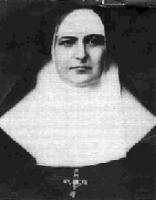

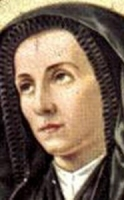



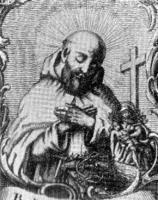


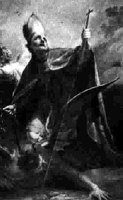


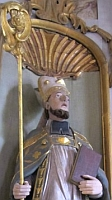
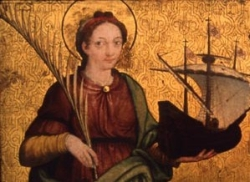
No comments:
Post a Comment